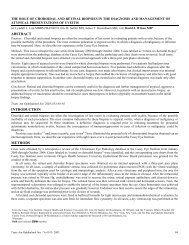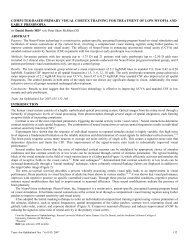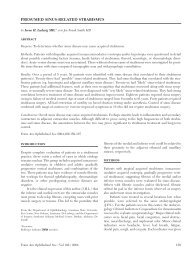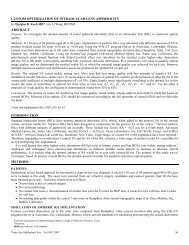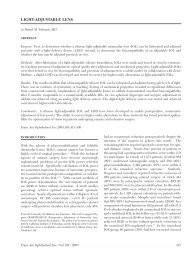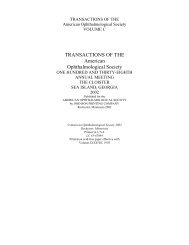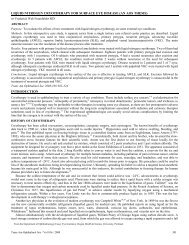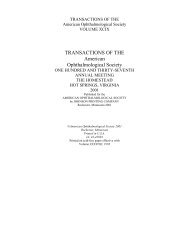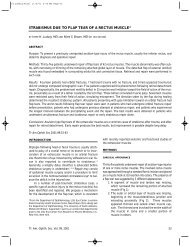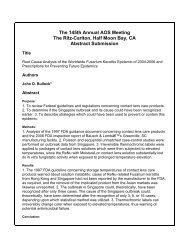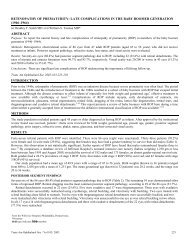Visual Acuity Assessment with Snellen and ETDRS Charts
Visual Acuity Assessment with Snellen and ETDRS Charts
Visual Acuity Assessment with Snellen and ETDRS Charts
- No tags were found...
Create successful ePaper yourself
Turn your PDF publications into a flip-book with our unique Google optimized e-Paper software.
Kaiserdifferent from the <strong>ETDRS</strong> protocol <strong>and</strong> could have led to an artificially larger difference between the charts. Falkenstein <strong>and</strong>colleagues tested only at 2 meters, whereas we tested the <strong>ETDRS</strong> charts at both 4-meter <strong>and</strong> 2-meter starting points. Thus, our studymimics the testing protocol in registration studies (<strong>ETDRS</strong> protocol) <strong>and</strong> may be more representative of the true difference betweenthe two charts.Third, Falkenstein <strong>and</strong> colleagues used the line assignment scoring for both the <strong>Snellen</strong> <strong>and</strong> <strong>ETDRS</strong> charts. The line assignmentmethod is considerably faster than the forced-choice paradigm required by the <strong>ETDRS</strong> protocol. 6 In the line assignment method, thetest is terminated when half or more of the letters are misread on a line, unlike the forced-choice paradigm, where testing continuesuntil an entire line is incorrect. Using the line assignment method increases the TRV. A higher TRV has implications for clinical trialdesign, since increased TRV will necessitate an increased sample size to demonstrate a true clinical change. For the <strong>ETDRS</strong> chart, theTRV is ±0.18 logMAR. 7,21,26 Thus, a change of at least 0.2 logMAR or 10 letters is necessary to exceed the test’s measurement error<strong>and</strong> be deemed a real change. 26 In contrast, the TRV of a <strong>Snellen</strong> chart is ±0.29 to 0.33 logMAR. 6,7 Moreover, the scaling problem ofthe <strong>Snellen</strong> chart means that the minimum clinically significant change, while almost 50% greater than the <strong>ETDRS</strong> chart, cannot bedefined in terms of a consistent number of letters or lines. In this study, we used the single letter forced-choice paradigm for the<strong>ETDRS</strong> charts, which likely made the differences between the two charts lower. More important, by following the <strong>ETDRS</strong> protocol,the differences reported in this study can be used to guide clinicians in interpreting their clinical results on <strong>Snellen</strong> charts, especiallywhen comparing them to published clinical trials.For patients <strong>with</strong> good visual acuity (>20/50), the difference between the <strong>Snellen</strong> <strong>and</strong> <strong>ETDRS</strong> charts was less than 1 line. Whenlooking at the average discrepancy, the differences ranged from 1.5 to 9 letters. This is similar to what Falkenstein <strong>and</strong> colleaguesreported in patients ≥20/30 (3.5 letters). 17 Thus, to answer one question posed in the “Introduction” section of this study, in patients<strong>with</strong> <strong>Snellen</strong> acuities of 20/50 to 20/70, it would be reasonable to consider laser photocoagulation for macular edema due to a branchvein occlusion, since the <strong>ETDRS</strong> protocol cutoff was 20/50 in the BVOS. 25 For clinical trials that call for patients <strong>with</strong> good vision, itis reasonable to assume that the <strong>ETDRS</strong> vision will roughly be <strong>with</strong>in 1 line of the <strong>Snellen</strong> acuity measured in one’s office. The onefactor that may skew these results is the fact that patients in this study were very motivated <strong>and</strong> pushed to obtain the best <strong>Snellen</strong>acuity possible, whereas in clinical practice this is not always the case. Thus, the variability may be slightly greater in clinical practice.On the other end of the scale, there was a greater variation in the visual acuity scores in eyes <strong>with</strong> poor visual acuity. In patients<strong>with</strong> poor acuity (≤20/200), the difference between the two charts was 2 lines. However, in patients who could not read the big “E”(20/400) on the <strong>Snellen</strong> chart, the variability was huge—up to 5 lines. Falkenstein 17 noted a similar discrepancy of 4 lines, <strong>and</strong> DrGary Abram 27 has suggested 3 to 4 lines in exudative AMD patients. The large difference between charts underscores the fact that the<strong>Snellen</strong> chart is unsuitable for patients who have severe vision loss or when evaluating low vision patients. The fact that the greatestdifferences in our study were seen in patients <strong>with</strong> poor visual acuity is not surprising, since the <strong>ETDRS</strong> chart can accurately measurelow visual acuities, whereas on the <strong>Snellen</strong> chart a 1- or 2-letter difference can be huge. The implication of this finding is thatpublished case series <strong>with</strong> low vision patients that use the <strong>Snellen</strong> chart must show at least a 5-line difference for any treatment tohave a clinically meaningful result.Unlike in other studies, patients of all ages were included in this study. As the patients’ age increased, the visual acuities worsened;however, the differences between the charts were not significantly different based on age. This is a known fact, as others have reportedthat logMAR visual acuity testing improves <strong>with</strong> age up to 29 years; thereafter, there is a loss of 0.029 logMAR per decade. 28 Othershave reported similar decay curves <strong>with</strong> age. 29Another goal of this study was to evaluate if there truly was a difference in the visual acuities measured on the <strong>ETDRS</strong> charts thatstart testing at either 4 or 2 meters. This is not an issue for most clinicians in practice but has tremendous importance in registrationtrials, as the FDA now requires all studies to use the 4 meter st<strong>and</strong>ard. In the past, 2 meters could be used, which saved time forpatients <strong>with</strong> poorer vision, since they would not see many letters at 4 meters anyhow. The regression analysis revealed a significantcorrelation between the visual acuity scores between 4 <strong>and</strong> 2 meters (R 2 = 0.9909); however, the slope was significantly different from1.0, indicating that there is a difference between the measurements at 4 <strong>and</strong> 2 meters (P < .0001). In fact, as visual acuity worsened,the differences between the testing distances increased <strong>with</strong> the 2 meter distance having better acuities. Others have noted nodifference in visual acuity scores on <strong>ETDRS</strong> charts as the testing distance was varied. 30 One explanation for the differences seen at 4<strong>and</strong> 2 meters is that patients get tired, incorrectly identifying letters on the 4 meter chart before it is moved to 2 meters, <strong>and</strong> thus theydo not try as hard at 2 meters. In any case, by requiring all studies to be performed at 4 meters, the FDA may have made the ability tosee real change marginally more difficult.Why is all this important? With the increasing reliance on evidenced-based medicine to guide treatment decisions, it is imperativeto be able to compare clinical studies to our own practice. Unfortunately, the measurement of visual acuity in terms of chart type <strong>and</strong>testing method can bias outcomes in clinical studies. For example, most phase III clinical studies rely on <strong>ETDRS</strong> charts <strong>and</strong> protocolacuity examinations, whereas most published case series rely on <strong>Snellen</strong> charts <strong>and</strong> variable vision testing protocols. 22,31 For example,in 128 reports using vision as an outcome in the 5 major ophthalmology journals in 2005, only 58.6% gave the chart design <strong>and</strong>, ofthese, 44% used the <strong>Snellen</strong> chart. 22 Another study found that <strong>Snellen</strong> vision was used in 118 (74%) of 160 studies in the US <strong>and</strong>United Kingdom literature. 31 It is important to remember that one cannot describe <strong>Snellen</strong> visual results in numbers of lines orfractions of lines, yet this is done routinely in the ophthalmic literature. In many of the reports evaluated in these studies, the methodsto determine visual acuity were so poorly described that replication of the studies could not be performed. 22 Some reports converted<strong>and</strong> discussed the results in logMAR format, while others converted <strong>and</strong> discussed the results in decimal format, which is even moreconfusing given the use of logMAR in most reports. Thus, one cannot easily compare the visual outcomes between these studies.An example of where this issue may affect clinical practice is in the field of retina, where numerous studies of bevacizumabTrans Am Ophthalmol Soc / 107 / 2009 321



